Table 2.
| Wrist Stability and Mobility | Starting Position | Ending Position | Scoring Criteria | Special Instructions | Verbal instructions |
|---|---|---|---|---|---|
Wrist stability elbow at 90°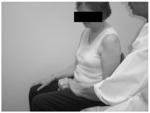
|
Shoulder at 0° in all planes, elbow at 90° with the forearm at 10° less than full pronation and wrist extended at least 15° beyond neutral. | NA | 0 = Correct starting position cannot be obtained. 1 = Wrist extension can be obtained but slight forward pressure to the dorsal surface of the hand causes movement towards wrist flexion or loss of any other aspect of starting position. 2 = Can retain wrist extension even with slight pressure to the dorsal side of the hand. |
Support: If the elbow cannot maintain 90° of flexion the RT is allowed to assist elbow flexion. The RT may use an open hand to provide support midway between the elbow and wrist on the anterior (palmer / volar) portion of the forearm. Assistance into elbow flexion requires the following caveats: If the Pt. is unable to extend the elbow to 90° the RT should not assist the elbow into extension. The RT should be careful not to provide pressure that aids proper positioning of shoulder (0° in all planes). Shoulder positioning should be maintained by the strength and coordination of the Pt. Pressure applied to the dorsal aspect of the Pt’s hand should be directly perpendicular to the angle of the hand. |
Starting Position: “Hold your arm at you side with your elbow at 90, as in grasping a bicycle handlebar, with your hand facing down.” Evaluation: “Raise your hand at the wrist. I am going to apply pressure to the back of your hand. Hold your hand firm, don’t let me move you.” |
Wrist flexion / extension, elbow at 90°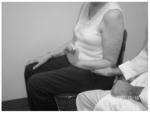
|
Shoulder at 0° in all planes, elbow at 90° with the forearm at 10° less than full pronation. | End ranges of full wrist flexion and full extension of the wrist are evaluated | 0 = Correct starting position cannot be obtained or movement toward wrist extension or flexion or cannot be achieved 1 = Partial active range of motion achieved. 2 = full active flexion and extension of the wrist with proper stating position maintained throughout movement as much or more than the unaffected side. |
Support: If the elbow cannot maintain 90° of flexion the RT is allowed to assist elbow flexion with the RT using an open hand midway between the elbow and wrist on the anterior (palmer / volar) portion of the forearm. Assistance into elbow flexion requires the following caveats: The RT should be careful not to provide pressure that aids proper positioning of shoulder (0° in all planes). Shoulder positioning should be maintained by the strength and coordination of the Pt. Wrist flexion may be attributable to force of gravity; score to the point at which the Pt. actively flexes wrist. Provide anti gravity support to the palmer surface of the hand to determine the end of the active range of motion. |
Starting Position “Hold your arm at your side with your elbow at 90° and the palm of your hand facing down, as if grasping a bicycle handlebar.” Evaluation “Raise and lower the hand, at the wrist, as much as possible.” |
Wrist stability with elbow at 0°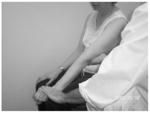
|
Wrist in 15° of flexion and shoulder in at least 25° of anywhere in the arc from flexion to abduction, elbow at 0 and 10° less than full pronation. | Same as starting position. | 0 = Correct starting position cannot be obtained. 1 = Wrist extension can be obtained but slight forward pressure to the dorsal surface of the hand causes movement towards wrist flexion or loss of any other aspect of starting position. 2 = Can retain wrist extension even with slight pressure to the dorsal side of the hand. |
Elbow extension may be lost either upon wrist extension or upon pressure against hand. The shoulder can be postured anywhere in the arc between flexion, through scaption and into pure abduction. Support: If the shoulder cannot be maintained in 25° of shoulder flexion, the RT is allowed to assist to position using an open hand, positioned just proximal to the elbow joint. |
Starting Position “Hold your arm at you side with your elbow straight, and the palm of your hand facing down. Evaluation “Raise your hand at the wrist. I am going to apply pressure to the back of your hand. Hold your hand firm, don’t let me move you.” |
Wrist flexion / extension, With elbow at 0°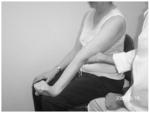
|
Shoulder in at least 25° of anywhere in the arc from flexion to abduction, elbow at 0 and 10° less than full pronation. | End ranges of full wrist flexion and full extension of the wrist are evaluated | 0 = Correct starting position cannot be obtained or movement toward wrist extension or flexion or cannot be achieved 1 = Partial active range of motion achieved or loss of any other aspect of starting position occurs during movement. 2 = full active flexion and extension of the wrist with proper stating position maintained throughout movement as much or more than the unaffected side without loss of any other aspect of starting position. |
Look for full elbow extension to cease when subject attempts wrist extension. The shoulder can be postured anywhere in the arc between flexion, trough scaption and into pure abduction. Support: If the shoulder cannot be maintained in 25° of shoulder flexion, the RT is allowed to assist to position using an open hand just proximal to the elbow joint. |
Starting Position “Hold your arm at your side with your elbow straight, and the palm of your hand facing down. Evaluation Raise and lower the hand, at the wrist, as much as possible.” |
| Starting Position | Ending Position | Scoring Criteria | Special Instructions | Verbal instructions | |
Circumduction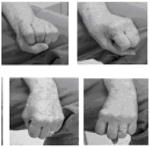
|
Shoulder at 0° in all planes, elbow at 90° with the forearm at 10° less than full pronation. | Full complete circumduction equal or greater than unaffected side. | 0 = Correct starting position cannot be obtained or no element of a circular motion at wrist available 1 = Partial circumduction achieved as evidenced of a full but smaller circle than unaffected side or movement is accomplished but the performed circular movement is jerky and/or broken and/or incomplete. |
Support: If the elbow cannot maintain 90° of flexion the RT is allowed to assist elbow flexion with the RT using an open hand midway between the elbow and wrist on the anterior portion of the forearm. Assistance into elbow flexion requires the following caveats: The RT should be careful not to provide pressure that aids proper positioning of shoulder (0° in all planes). Shoulder positioning should be maintained by the strength and coordination of the Pt. Circumduction is performed by mixing elements of wrist flexion, ulnar deviation, wrist extension and radial deviation in such a way that a complete and unbroken circle is formed. Verbally cuing the Pt. with an explanation of these four elements of Circumduction can be useful. Circumduction can be completed clockwise or counterclockwise. |
Starting Position “Hold your arm at your side with your elbow at 90° and the palm of your hand facing down, as if you are grasping a bicycle handlebar” Evaluation “Wth the back of your hand facing the ceiling the entire time, and without moving your forearm, make a circle with your hand by moving the wrist” |
| Hand | |||||
| Starting Position | Ending Position | Scoring Criteria | Special Instructions | Verbal instructions | |
Mass Flexion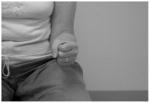
|
Forearms on lap in a resting posture. Hand and fingers as “open” as possible with as much finger and thumb extension as possible. |
Full fisted posture equal or greater than the unaffected side. Thumb on the outside of the fingers postured between the PIP and DIP of index and long fingers. | 0 = no movement towards flexion of any of the joints of any of the digits 1 = Some flexion at any or all joints of the digits 2 = full flexion of all digits at all joints equal or greater than the unaffected side |
Passive stretching of the fingers by the patient is allowed prior to testing. Forearm can be postured anywhere from full supination to full pronation |
Starting Position “Hold your arm at your side with your elbow at 90° and the palm of your hand as open as possible. Evaluation Make as much of a fist as you can, with the thumb on the outside of the fingers. |
Mass Extension
|
Forearms on lap in a resting posture. Hand in full fisted posture with all digits flexed as possible at all joints. |
Full extension of all joints of all digits | 0 = cannot release from mass flexion 1 = can release a mass posture 1 = can extend fingers partially 2=Full extension of all digits at all joints |
Starting position may involve the hand being placed by Pt. or RT into maximum possible flexion of all MCP and IP joints of all fingers and the thumb. |
Starting Position “Hold your arm at your side with your elbow at 90° and your hand in as much of a fist as possible Evaluation Open the hand as much as possible” |
| ALL GRASPING TASKS | The following position applies to all of the grasping tasks: Shoulder at 0° in all planes and the elbow at 90°. Forearm neutral pronation / supination. When possible, the wrist is maintained in 0°. However, if wrist cannot be held in 0 (i.e. it is held in flexion) the score is not affected. |
This rule applies to all of the hand (C) movements, grasps and details: Support: If the elbow cannot maintain 90° of flexion the RT is allowed to assist elbow flexion with the RT using an open hand midway between the elbow and wrist. |
|||
| Starting Position | Ending Position | Scoring Criteria | Special Instructions | Verbal instructions | |
Grasp A: Hook Grasp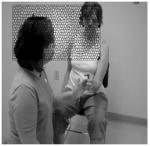
|
Hand in hook grasp position: Digits 2–5 MCP fully extended = or > unaffected side and fully flexed PIP and DIP |
Hand in hook grasp position: Digits 2–5 MCP fully extended = or > unaffected side and fully flexed PIP and DIP |
0 = Starting position cannot be attained 1 = Starting position is broken upon application of pressure 1 = Grasp is broken upon application of pressure 2 = Hook grasp starting position is maintained throughout performance of task. |
The starting position is extraordinarily hard for neurological conditions involving hemiparesis. Pressure is provided with the RT using his/her own hook grasp in direct opposition to that of the Pt. Pressure provided should be approximate to the weight of the RT forearm with gravity. |
Starting Position “Hold your arm at your side with your elbow at 90° and your hand straight at all of your knuckles. Evaluation I am going to apply pressure away from you at your fingers. Hold your hand firm, don’t let me move you” |
| Starting Position | Ending Position | Scoring Criteria | Special Instructions | Verbal instructions | |
Grasp B: Radial Grasp (Thumb Flexion)
|
Hand and fingers as “open” as possible. All thumb joints and all interphalangeal joints must be postured at 0°. Thumb can be postured at any degree of extension such that it is separated from the lateral side of 2nd digit’s MCP. |
Hand and fingers as “open” as possible. All thumb joints at 0° grasping a piece of paper between the DIP of the thumb and the lateral surface of the metacarpal and proximal phalanx of the 2nd digit. | 0 = Starting position cannot be attained 1 = Starting position is broken upon onset of tug by RT of paper 1 = Pt is unable to hold paper against tug 2 = Hook grasp and starting position are maintained throughout performance of task. |
The RT may be able to tell from the “mass extension” movement, that the Pt. Is unable to achieve the starting position of this task. As the thumb is flexed (adducted) towards the 2nd digit there will be tendency to flex all the fingers at all joints. Verbally cue the Pt not do this. If, however, the Pt is not able to keep the fingers straight, score as is applicable. |
Starting Position “Hold your arm at your side with your elbow at 90° and your hand as open as possible.” Evaluation “Grasp this paper between your thumb and the side of your index finger. Keep your fingers as straight as possible. I am going to gently tug the paper, but try to hold the paper in place.” |
Grasp C: Pincer Grasp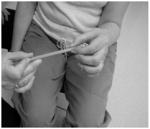
|
Thumb and index finger open in anticipation | As the pencil is pulled horizontally away from the midline of the Pt. the grasp and the position of the extremity are maintained | 0 = Starting position cannot be attained 1 = Starting position is broken upon onset of tug by RT of pencil 1 = Pt is unable to hold pencil against tug 2 = Pincer Grasp and starting position are maintained throughout performance of task. |
Pts. with hemiparesis may show an ability to complete a pinching grasp in which contact is maintained at a variety of points on the index finger and thumb. A pincer grasp specifically requires opposition between the pad of the thumb and the pad of the index finger. |
Starting Position “Hold your arm at your side with your elbow at 90°. Now, grasp this paper between the pads of your thumb and index finger.” Evaluation “I am going to gently tug the pencil, but try to hold the pencil in place.” |
| Starting Position | Ending Position | Scoring Criteria | Special Instructions | Verbal instructions | |
Grasp D: Cylinder Grasp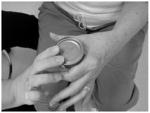
|
Thumb as extended as possible | As the can is pulled horizontally away from the midline of the Pt. the grasp and the position of the extremity are maintained | 0 = Starting position cannot be attained 1 = Starting position is broken upon onset of tug by RT of can 1 = Pt is unable to hold can against tug 2 =Cylindrical Grasp and starting position are maintained throughout performance of task. |
The can should meet the area between the thumb and the index finger in a way at least equal to the unaffected side. There is a tendency for patients with hemiparesis to not be able to extend the thumb wide enough to accept the can without the RT pushing the can into place. To eliminate this possibility, have the can meet the hand at the web space prior to touching any other part of the hand or fingers. |
Starting Position “Hold your arm at your side with your elbow at 90°. Now, grasp this can between your thumb and index finger.” Evaluation “I am going to gently tug the can, but try to hold the can in place.” |
Grasp E: Spherical Grasp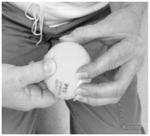
|
Fingers as actively extended as possible | As the ball is pulled horizontally away from the midline of the Pt. as the grasp and the position of the extremity are maintained | 0 = Starting position cannot be attained 1 = Starting position is broken upon onset of tug by RT of ball 1 = Pt is unable to hold ball against tug 2 = Spherical Grasp and starting position are maintained throughout performance of task. |
A tennis ball is used. All 5 fingers should be in contact with the ball. There is a tendency for patients with hemiparesis to not be able to extend one or more of the fingers enough to accept the ball without the RT pushing the ball into place. To eliminate this possibility, have the ball meet the palm surface prior to touching any other part of the hand. |
Starting Position “Hold your arm at your side with your elbow at 90°.” Evaluation “Grasp this in your hand and fingers as if you want to throw it. Now, I am going to gently tug the ball, but try to hold the ball in place.” |
Note: “RT” denotes rater; “Pt” denotes patient; “MCP” denotes meta carpal phalangeal; “DIP” denotes distal interphalangeal; “PIP” denotes proximal interphalengeal.
